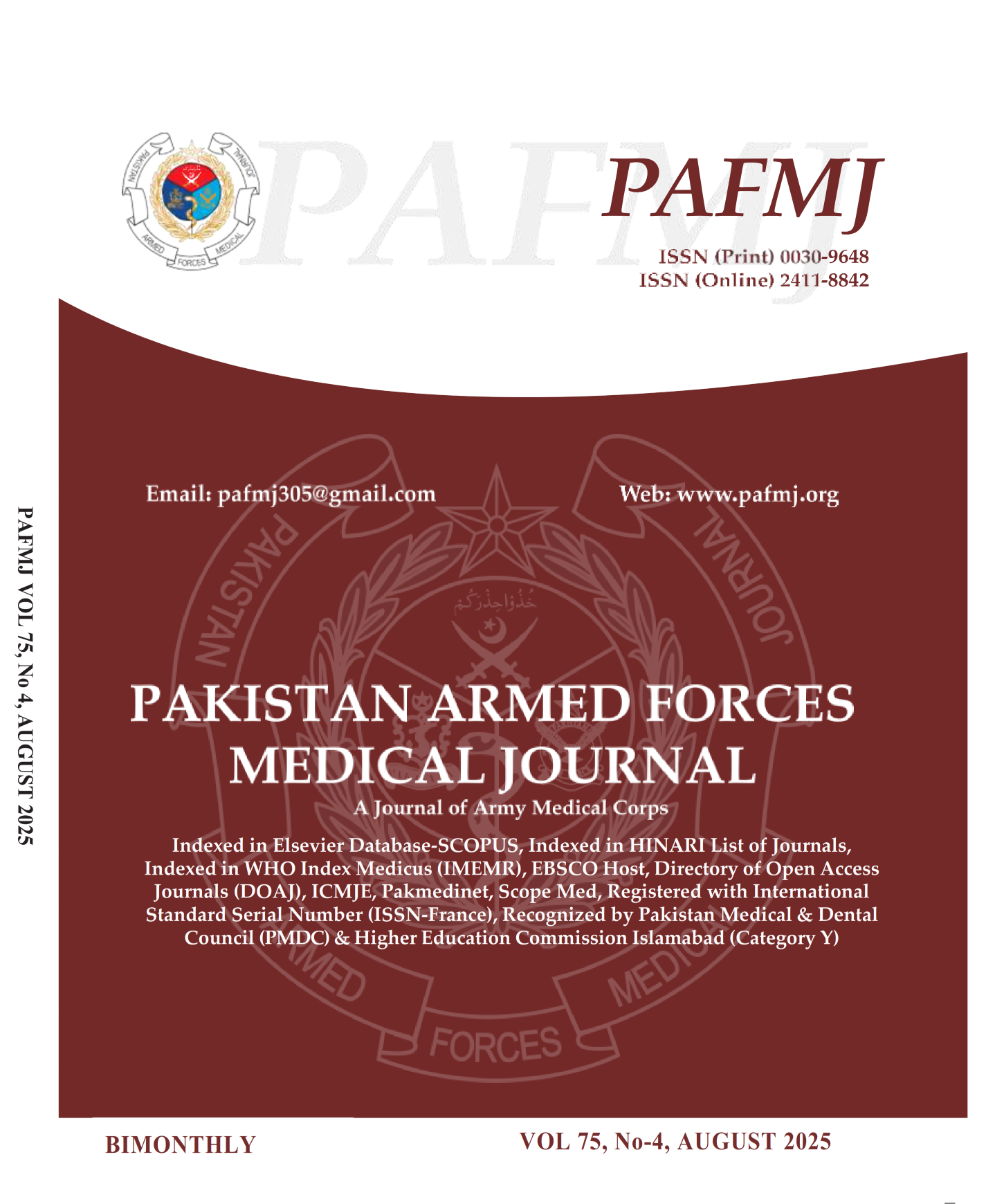Efficacy of the National Early Warning Score (NEWS) in Predicting In-Hospital Mortality in Surgical High Dependency Unit (HDU): A Prospective Study
DOI:
https://doi.org/10.51253/pafmj.v75i4.11961Keywords:
HDU, In-hospital mortality, Mortality risk, National Early Warning Score, Rapid response systemAbstract
Objective: To assess efficacy of the National Early Warning Score in predicting in-hospital mortality in surgical High Dependency Unit.
Study Design: Prospective longitudinal study.
Place and Duration of Study: Surgical HDU, Department of Surgery, Combined Military Hospital, Rawalpindi Pakistan, from Jul to Dec 2023.
Methodology: Patients admitted to surgical HDU were included by non-probability consecutive sampling. NEWS score was recorded for each patient within 24 hours of admission and classified into three triggering thresholds: low-risk (NEWS 1 to 4), medium-risk (NEWS 5 to 6) and high-risk (NEWS 7 or higher). Patients discharged within 3 days of admission, with missing NEWS variables and first NEWS recorded after 24 hours of admission were excluded. Demographic data and clinical characteristics were noted. Final outcome was recorded on 30th day after day of admission.
Results: The study analyzed 350 patients admitted to surgical HDU, where 103(29.4%) patients died within 30 days after admission. Mortality was considerably higher in patients with high-risk threshold (92.1%) compared to medium-risk (54.9%) and low-risk (2.2%). High-risk NEWS threshold (≥7) at admission had sensitivity of 68% and specificity of 98% as a predictor of in-hospital mortality, AUC 0.945 (95% CI 0.916-0.974) with p-value<0.001, making it statistically significant. Patients with high-risk NEWS threshold on day of admission had less than 10% survival at 30 days.
Conclusion: NEWS may be used as an objective scoring system to predict the risk of in-hospital mortality in surgical HDU settings.
Downloads
References
1. Merchant RM, Yang L, Becker LB, Berg RA, Nadkarni V, Nichol G, et al. Incidence of treated cardiac arrest in hospitalized patients in the US. Crit Care Med 2011; 39(11): 2401–2406. https://doi.org/10.1097/CCM.0b013e3182257459
2. Le Guen M, Tobin A. Epidemiology of in-hospital mortality in acute patients admitted to a tertiary-level hospital. Intern Med J 2016; 46(4): 457–464. https://doi.org/10.1111/imj.13019
3. Salluh JI, Soares M. ICU severity of illness scores: APACHE, SAPS and MPM. Curr Opin Crit Care 2014; 20(5): 557–565.
4. Zimmerman JE, Kramer AA, McNair DS, Malila FM. Acute Physiology and Chronic Health Evaluation (APACHE) IV: hospital mortality assessment for today's critically ill patients. Crit Care Med 2006; 34(5): 1297–1310.
5. Smith GB, Prytherch DR, Meredith P, Schmidt PE, Featherstone PI. The ability of the National Early Warning Score (NEWS) to discriminate patients at risk of early cardiac arrest, unanticipated intensive care unit admission, and death. Resuscitation 2013; 84(4): 465–470.
6. Alam N, Hobbelink EL, van Tienhoven AJ, van de Ven PM, Jansma EP, Nanayakkara PWB et al. The impact of the use of the Early Warning Score (EWS) on patient outcomes: a systematic review. Resuscitation 2014; 85(5): 587–594. https://doi.org/10.1016/j.resuscitation.2014.01.013
7. Williams B, Alberti G, Ball C, Bell D, Binks R, Durham L et al. National Early Warning Score (NEWS): standardising the assessment of acute-illness severity in the NHS. London: The Royal College of Physicians; 2012.
8. Uppanisakorn S, Bhurayanontachai R, Boonyarat J, Kaewpradit J. National Early Warning Score (NEWS) at ICU discharge can predict early clinical deterioration after ICU transfer. J Crit Care 2018; 43: 225–229.
9. Lee YS, Choi JW, Park YH, et al. Evaluation of the efficacy of the National Early Warning Score in predicting in-hospital mortality via the risk stratification. J Crit Care 2020; 47: 222–226. https://doi.org/10.1016/j.jcrc.2018.07.011
10. Spangfors M, Bunkenborg G, Molt M, Samuelson K. The National Early Warning Score predicts mortality in hospital ward patients with deviating vital signs: A retrospective medical record review study. J Clin Nurs. 2019; 28: 1216–1222. https://doi.org/10.1111/jocn.14728
11. Azam F, Latif MF, Farooq A, Tirmazy SH, Al Shahrani S, Bashir S et al. Performance status assessment by using ECOG (Eastern Cooperative Oncology Group) score for cancer patients by oncology healthcare professionals. Case Rep Oncol 2019; 12(3): 728–736.
https://doi.org/10.1159/000503095
12. Vetrano DL, Foebel AD, Marengoni A, Brandi V, Collamati A, Heckman GA, et al. Chronic diseases and geriatric syndromes: the different weight of comorbidity. Eur J Intern Med 2020; 27: 62–67.
13. Smith GB, Prytherch DR, Schmidt PE, Featherstone PI, Kellett J, Deane B, et al. Should age be included as a component of track and trigger systems used to identify sick adult patients? Resuscitation. 2020; 78(2): 109–115.
14. Formiga F, Ferrer A, Sanz H, Marengoni A, Alburquerque J, Pujol R et al. Patterns of comorbidity and multimorbidity in the oldest old: the Octabaix study. Eur J Intern Med 2013; 24(1): 40–44.
15. Moreno RP, Metnitz PG, Almeida E, Jordan B, Bauer P, Campos RA, et al. SAPS 3 from evaluation of the patient to evaluation of the intensive care unit. Part 2: development of a prognostic model for hospital mortality at ICU admission. Intensive Care Med 2005; 31(10): 1345–1355.
16. Tirkkonen J, Huhtala H, Hoppu S. In-hospital cardiac arrest after a rapid response team review: a matched case-control study. Resuscitation 2018; 126: 98–103.
17. wnarifin.github.io > Sample size calculator [Internet]. Available from:
https://wnarifin.github.io/ssc/sssnsp.html
18. Wang C, Xu R, Zeng Y, Zhao Y, Hu X. A comparison of qSOFA, SIRS and NEWS in predicting the accuracy of mortality in patients with suspected sepsis: A meta-analysis. PLoS ONE. 2022; 17(4): e0266755.
Downloads
Published
Issue
Section
License
Copyright (c) 2025 Ahmed Tariq, Shahid Mehmood Khan, Abdul Hameed, Chaudhary Imran Ashraf, Maira Wajahat, Muhammad Ajmal Leghari

This work is licensed under a Creative Commons Attribution-NonCommercial 4.0 International License.















